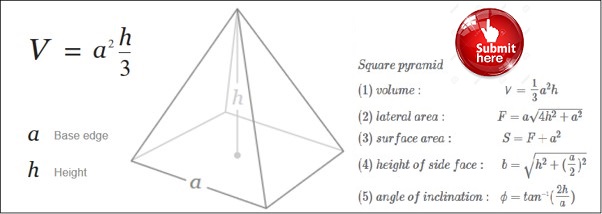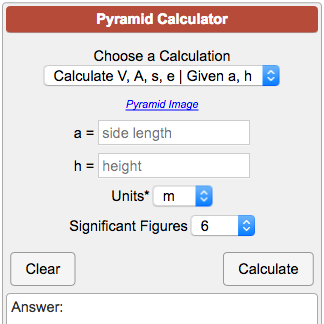
In this way, the volume of a square pyramid is defined as in terms of units occupied by the pyramid. = 1 2 p l + b where p represents the perimeter of the base, l the slant height and b the area of the base. (2) the corresponding surface area and volume are s = a(a+sqrt(a^2+4h^2)) (3) v = 1/3a^2h. The three main parts of any pyramid's: In this way, the volume of a square pyramid is defined as in terms of units occupied by the pyramid. B is the area of square base and h is the height of the square pyramid.
A square pyramid is a pyramid with a square base. For a regular pyramid, we can apply the following formula, given the side of square face and height, 1/3 × a 2 × h, where 'a' is the side of the square faces and 'h' is the height of the pyramid. It has five sides, a square surface and four triangle surfaces which makes it a pentahedron. The pyramid faces will connect the bases with apex ahead. Volume of a regular hexagonal prism. The three main parts of any pyramid's: Now, let us consider the side of the square base is 'b' and the height of the square base is 'h', then the area of the base will be b=b 2 and the volume of a square pyramid will be given as v=1/3b 2 h
The formula to calculate the surface area of a square pyramid is, surface area = a 2 + 2a√(a 2 /4) + h 2, where h is the height h and a is the base edge of the square pyramid.
H= height is the height from apex to the end of pyramid. The general formula for the total surface area of a regular pyramid is t. The formula to calculate the surface area of a square pyramid is, surface area = a 2 + 2a√(a 2 /4) + h 2, where h is the height h and a is the base edge of the square pyramid. The lateral area of a right pyramid can be calculated by multiplying half of the perimeter of the base by the slant height. It has five sides, a square surface and four triangle surfaces which makes it a pentahedron. Volume of a square pyramid given base and lateral sides. The above surface area of a square pyramid formula is defined as b 2 + 2bl. This is summarized by the formula: A square pyramid is also known as a polyhedron because it has a square base and four triangular faces. A polyhedron that has a polygonal base and triangles for sides, is a pyramid. Height of a regular hexagonal prism. The pyramid's base is a square with 8cm sides, so compute its area by multiplying 8cm by 8cm (recall: The three main parts of any pyramid's: The base of a pyramid may be of any shape.
(2) the corresponding surface area and volume are s = a(a+sqrt(a^2+4h^2)) (3) v = 1/3a^2h. L = a x √ (4h 2 +a 2) where, l = lateral surface area. The above surface area of a square pyramid formula is defined as b 2 + 2bl. The surface area of the square pyramid formula is the sum of the surface areas of the base and the four triangular faces. The lateral area of a right pyramid can be calculated by multiplying half of the perimeter of the base by the slant height. The highest point where all the sides meet together is referred to as the apex. What is the formula for a right pyramid?

Volume of a square pyramid given base side and height.
Height of a right square prism. V = (1 / 3) b h. There are many possible polygonal bases for a pyramid, but a square pyramid is a pyramid in which the base is a square. The formula to calculate the surface area of a square pyramid is, surface area = a 2 + 2a√(a 2 /4) + h 2, where h is the height h and a is the base edge of the square pyramid. The volume of a square pyramid formula is = h All the triangles meet at a point on the top of the pyramid that is called apex. The area of a square equals side times side). A polyhedron that has a polygonal base and triangles for sides, is a pyramid. The most common parts of a pyramid are taken as base and the apex. Review how to find the surface area of a square pyramid.
The volume of a square pyramid formula is = h The area of a square equals side times side). Square pyramid formulas derived in terms of side length a and height h: A square pyramid could be defined as the polyhedron with a square base and four triangular faces too. There is one single point where all triangular faces are meeting is called the apex. Now, let us consider the side of the square base is 'b' and the height of the square base is 'h', then the area of the base will be b=b 2 and the volume of a square pyramid will be given as v=1/3b 2 h

Volume of a right square prism.
The formula to calculate the surface area of a square pyramid is, surface area = a 2 + 2a√(a 2 /4) + h 2, where h is the height h and a is the base edge of the square pyramid. Volume of a right square prism. Height of a right square prism. Watch this very detailed and step by step video. A square pyramid is also known as a polyhedron because it has a square base and four triangular faces. Review how to find the surface area of a square pyramid. Plug the measurements ( b = 64cm2, h = 12cm) into the formula for volume, then simplify. On the basis of shape of the base, pyramids are named differently. The lateral area of a right pyramid can be calculated by multiplying half of the perimeter of the base by the slant height. Volume = (1/3) * base_area * height, where height is the height from the base to the apex.
Faces usually take the shape of an isosceles triangle square pyramid. Square pyramid is solid three dimensional object, its a pyramid with square base.

Now, let us consider the side of the square base is 'b' and the height of the square base is 'h', then the area of the base will be b=b 2 and the volume of a square pyramid will be given as v=1/3b 2 h

For a regular pyramid, we can apply the following formula, given the side of square face and height, 1/3 × a 2 × h, where 'a' is the side of the square faces and 'h' is the height of the pyramid.

The volume of a square pyramid is found using the formula using the base area and height given as, v = 1/3 × base area × height.

The lateral area of a right pyramid can be calculated by multiplying half of the perimeter of the base by the slant height.
The surface area of the square pyramid can also be calculated as, surface area = a 2 + 2al, where l is the slant height and a is the base edge of the square pyramid.

A = side of the pyramid.

The sides of a triangular pyramid are all triangles.

V = 1/3a2h or v =13 × b2 × h, where 'v' is volume, 'b' or 'a' refers to base length and 'h' means height.

In this way, the volume of a square pyramid is defined as in terms of units occupied by the pyramid.

The above surface area of a square pyramid formula is defined as b 2 + 2bl.

Square pyramid formulas derived in terms of side length a and height h:

The highest point where all the sides meet together is referred to as the apex.

Online calculators and formulas for a pyramid and other geometry problems.

On the basis of shape of the base, pyramids are named differently.

The above surface area of a square pyramid formula is defined as b 2 + 2bl.

H = height of the pyramid.

(4) the volume of a square pyramid in the special case h=a/2 can be found.

B = (8cm) (8cm) = 64cm 2.

Online calculators and formulas for a pyramid and other geometry problems.

Volume of a right square prism.

H = height of the pyramid.

The volume of this pyramid can be found using the formula given below.

B is the area of square base and h is the height of the square pyramid.
Height of a right square prism.

Just square the base and add with twice the base and length to get the resultant value.

Height of a right square prism.

In this way, the volume of a square pyramid is defined as in terms of units occupied by the pyramid.

Review how to find the surface area of a square pyramid.

The volume of a square pyramid formula is = h

A polyhedron that has a polygonal base and triangles for sides, is a pyramid.

The volume of a square pyramid is found using the formula using the base area and height given as, v = 1/3 × base area × height.

On the basis of shape of the base, pyramids are named differently.

Height of a right square prism.
= 1 2 p l + b where p represents the perimeter of the base, l the slant height and b the area of the base.

The most common parts of a pyramid are taken as base and the apex.

L = a x √ (4h 2 +a 2) where, l = lateral surface area.
0 Komentar